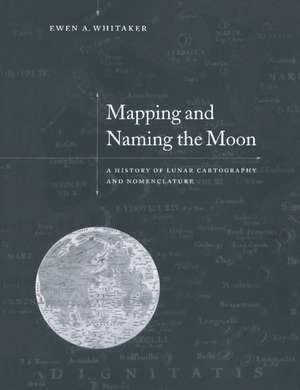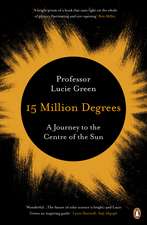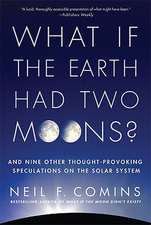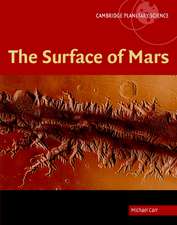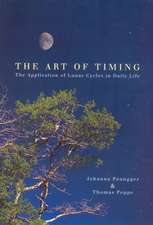Mapping and Naming the Moon: A History of Lunar Cartography and Nomenclature
Autor Ewen A. Whitakeren Limba Engleză Paperback – 10 dec 2003
Preț: 424.84 lei
Preț vechi: 477.35 lei
-11% Nou
Puncte Express: 637
Preț estimativ în valută:
81.29€ • 88.58$ • 68.50£
81.29€ • 88.58$ • 68.50£
Carte tipărită la comandă
Livrare economică 24 aprilie-08 mai
Preluare comenzi: 021 569.72.76
Specificații
ISBN-13: 9780521544146
ISBN-10: 0521544149
Pagini: 264
Ilustrații: 158 b/w illus.
Dimensiuni: 189 x 247 x 16 mm
Greutate: 0.49 kg
Ediția:Revised.
Editura: Cambridge University Press
Colecția Cambridge University Press
Locul publicării:Cambridge, United Kingdom
ISBN-10: 0521544149
Pagini: 264
Ilustrații: 158 b/w illus.
Dimensiuni: 189 x 247 x 16 mm
Greutate: 0.49 kg
Ediția:Revised.
Editura: Cambridge University Press
Colecția Cambridge University Press
Locul publicării:Cambridge, United Kingdom
Cuprins
Preface; Introduction; Part I. First Era: From Prehistoric Images to Archetype Map: 1. Pre-telescopic lunar observations; 2. Early telescopic observations of the Moon; 3. Van Langren (Langrenus) and the birth of selenography; 4. Six more years of sporadic activity; Part II. Second Era: From Archetype to Maturity: 5. 140 years of sporadic activity; 6. A globe, tree rings, and a city; 7. Lunar cartography comes of age; Part III. Third Era: From proliferation to standardisation: 8. Lunar mapping in the Victorian period; 9. Nomenclature gets international attention; Part IV. The Space Age Demands Changes: 10. Setting up guidelines; 11. Planets and satellites set the rules. Appendices 1 - 22.
Recenzii
' … a welcome new book on the history of lunar mapping. Ewen Whitaker probably knows more about selenocartography and lunar nomenclature than anyone alive. This fascinating book will provide guidelines and lessons for mapping and nomenclature when we finally return to the Moon.' Charles A. Wood, Sky and Telescope
'This is just the sort of book I love. It is unusual and there is nothing on my bookshelf quite like it. It is eminently readable and I can see myself referring to it time after time. I can imagine any astronomer, amateur or professional, who has an interest in the Moon, the history of astronomy, or astronomers in general, enjoying this book greatly.' Dr David W. Hughes, University of Sheffield
' … very detailed, with excellent reproductions of the various maps … Whitaker and his publishers are to be congratulated for a book that is certain to remain the standard.' Patrick Moore, The Times Higher Education Supplement
'Ewen Whitaker has been in the forefront of lunar cartography for many years, and is probably the world's leading authority on the subject of nomenclature. He is therefore uniquely qualified to write this book, and he has carried out his task well. The book is very detailed, with excellent reproductions of the various maps; the text has clearly taken many years of careful, painstaking research, and contains much information not to be found elsewhere. Whitaker and his publishers are to be congratulated upon producing a book that in this particular branch of scientific history, is certain to remain the standard.' Patrick Moore, Endeavour
'The book is well written and produced. The book is comprehensive and likely to become the definitive work.' Clive D, Labour and Industry
'Whitaker presents us with a scholarly, yet most readable, insight into both the history of the drawing and production of Moon maps and the vagaries of naming lunar features.' David W. Hughes, The Observatory
'This is just the sort of book I love. It is unusual and there is nothing on my bookshelf quite like it. It is eminently readable and I can see myself referring to it time after time. I can imagine any astronomer, amateur or professional, who has an interest in the Moon, the history of astronomy, or astronomers in general, enjoying this book greatly.' Dr David W. Hughes, University of Sheffield
' … very detailed, with excellent reproductions of the various maps … Whitaker and his publishers are to be congratulated for a book that is certain to remain the standard.' Patrick Moore, The Times Higher Education Supplement
'Ewen Whitaker has been in the forefront of lunar cartography for many years, and is probably the world's leading authority on the subject of nomenclature. He is therefore uniquely qualified to write this book, and he has carried out his task well. The book is very detailed, with excellent reproductions of the various maps; the text has clearly taken many years of careful, painstaking research, and contains much information not to be found elsewhere. Whitaker and his publishers are to be congratulated upon producing a book that in this particular branch of scientific history, is certain to remain the standard.' Patrick Moore, Endeavour
'The book is well written and produced. The book is comprehensive and likely to become the definitive work.' Clive D, Labour and Industry
'Whitaker presents us with a scholarly, yet most readable, insight into both the history of the drawing and production of Moon maps and the vagaries of naming lunar features.' David W. Hughes, The Observatory
Descriere
Historical maps and rare photographs illustrate four centuries of mapping the Moon.
